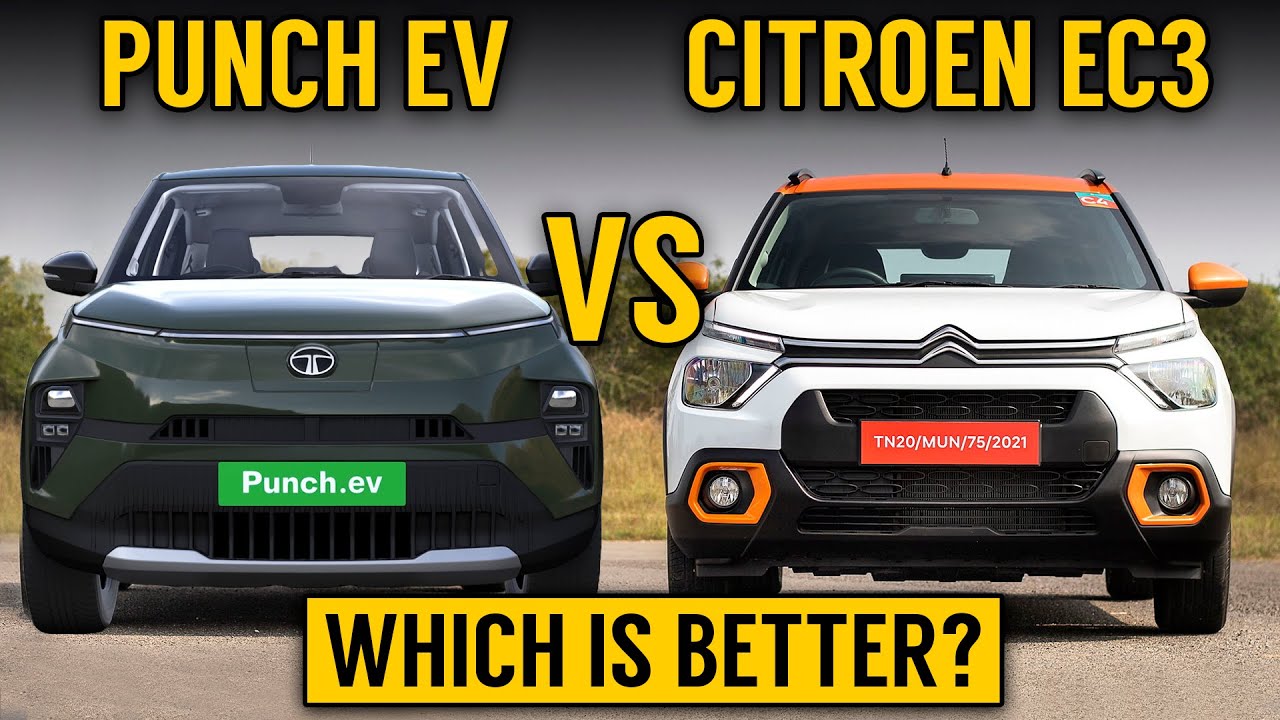Choosing the right electric vehicle (EV) can be tricky, especially when navigating a new market filled with exciting options. In India, two strong contenders have emerged in the compact electric car segment: the Tata Punch EV Long Range and the Citroen eC3. Both offer impressive features and competitive pricing, but which one reigns supreme in terms of real-world driving range? This comprehensive guide dives deep into the specs, performance, features, and value proposition of both EVs, helping you make an informed decision.

Unveiling the Contenders: Tata Punch EV Long Range vs Citroen eC3
Tata Punch EV Long Range: Launched in January 2024, the Punch EV boasts two battery pack options: a 25 kWh standard range and a 35 kWh long range. This long-range variant positions itself as a direct competitor to the Citroen eC3. The Punch EV packs a punch (pun intended) with a more powerful electric motor, translating to a peppier driving experience.
Citroen eC3: This sole-battery-pack contender from Citroen offers a single 29.2 kWh battery. While it might not boast the highest claimed range, the eC3 focuses on spacious interiors and a comfortable ride, making it a compelling choice for city commutes.
Decoding the Specs: Battery, Power, and Claimed Range
Let’s delve into the technical specifications that truly differentiate these two EVs:
| Feature | Tata Punch EV Long Range | Citroen eC3 |
|---|---|---|
| Battery Pack | 35 kWh | 29.2 kWh |
| Power | 122 PS | 57 PS |
| Torque | 190 Nm | 143 Nm |
| Claimed Driving Range | 421 km | 320 km |
drive_spreadsheetExport to Sheets
On paper, the Tata Punch EV Long Range boasts a clear advantage with its larger battery pack, translating to a claimed range 100 km higher than the Citroen eC3. However, real-world driving conditions often paint a different picture.
Real-World Range: The Plot Twist
Here’s where things get interesting. Extensive testing reveals that despite the larger battery, both the Punch EV Long Range and the eC3 deliver a similar real-world driving range of around 250-260 km on a single charge.
The reason? The Punch EV’s more powerful motor, while offering a thrilling drive, consumes more battery power to deliver that extra pep. This negates the advantage of the larger battery size in terms of real-world range.
Important Disclaimer: Remember, the actual driving range can vary depending on factors like driving style, traffic conditions, weather, and battery health. Always practice eco-friendly driving habits to maximize your EV’s range.
Feature Face-Off: Beyond the Battery
While range is a crucial factor, features also play a significant role in the buying decision. Here’s a breakdown of what each EV offers:
Tata Punch EV Long Range:
- Feature-rich with amenities like cruise control, push-button start, automatic AC, air purifier, and paddle shifters for regenerative braking.
- Offers superior safety features like six airbags, electronic stability control (ESC), hill hold control, and a rear parking camera.
Citroen eC3:
- Focuses on a spacious cabin and a comfortable ride quality.
- Offers a decent touchscreen infotainment system with Android Auto and Apple CarPlay.
- Starting from July 2024, all Citroen cars, including the eC3, will come standard with six airbags. (Previously, it only offered dual front airbags).
Value Proposition: Striking a Balance
Citroen eC3: This EV caters to budget-conscious buyers who prioritize a comfortable city commute and prioritize a value-driven proposition. It offers a good balance of features and a decent real-world range at a competitive price point.
Tata Punch EV Long Range: For those seeking a feature-rich experience with a peppier drive, the Punch EV Long Range emerges as a strong contender. While the real-world range might not significantly exceed the eC3, the additional features and power might justify the slightly higher price tag, especially for mid-spec variants that offer excellent value compared to the top-spec eC3.
Frequently Asked Questions:
Q: Which EV offers faster charging?
A: Unfortunately, official charging time data for both EVs is yet to be released. However, based on battery capacity, the Punch EV Long Range with its larger 35 kWh battery might take slightly longer to charge compared to the eC3’s 29.2 kWh battery. Both EVs are likely to support fast charging options, but confirmation and charging speeds will need to be awaited from the manufacturers.
Q: Is there a significant difference in boot space between the two EVs?
A: While exact boot space figures are not yet available for the Punch EV Long Range, the standard range Punch EV offers 222 liters of boot space. The Citroen eC3 boasts a slightly larger boot space of 252 liters. This marginal difference might not be a deal-breaker for most users, but if cargo capacity is a major concern, the eC3 might have a slight edge.
Q: What about after-sales service and service network reach?
A: Tata Motors has a wider service network in India compared to Citroen. This could be a factor to consider, especially if you reside in a smaller town or city. However, Citroen is rapidly expanding its service network, and ownership shouldn’t be a major concern in metro cities.
Q: Is there a government subsidy available for these EVs?
A: Yes, both the Tata Punch EV Long Range and the Citroen eC3 are eligible for Indian government subsidies under the FAME-II scheme. The exact amount of subsidy can vary depending on the state and specific variant of the EV. It’s advisable to check with the respective dealerships for the most up-to-date subsidy information.




